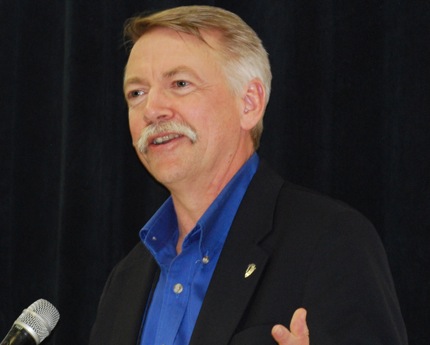 Jonathan Jarvis speaking at the APPL conference in San Diego (Photo by Beth Pratt)Jonathan Jarvis was confirmed as the Director of the National Park Service in September of 2009. A 30-year veteran of the National Park Service (NPS), he has served as regional director of the agency’s Pacific West Region, and as superintendent of Mount Rainier National Park in Ashford, Washington, Craters of the Moon National Monument in Idaho, and Wrangell-St. Elias National Park & Preserve in Alaska.
Jonathan Jarvis speaking at the APPL conference in San Diego (Photo by Beth Pratt)Jonathan Jarvis was confirmed as the Director of the National Park Service in September of 2009. A 30-year veteran of the National Park Service (NPS), he has served as regional director of the agency’s Pacific West Region, and as superintendent of Mount Rainier National Park in Ashford, Washington, Craters of the Moon National Monument in Idaho, and Wrangell-St. Elias National Park & Preserve in Alaska.
During the Association of Partners for Public Lands conference yesterday, Jarvis updated a standing-room only audience about the latest issues facing the NPS, from climate change to firearms in parks. In our interview, he elaborated on some of his priorities for the agency.
You have called climate change one of the greatest challenges the National Park Service has ever faced. How do you see the service addressing this issue?
The NPS has a unique responsibility with climate change in protecting the special places we have been entrusted to care for. So much of the climate change issue is framed in terms of green energy and carbon sequestration, but we also have to deal with the preservation aspect.
We fulfill many significant roles in the fight against climate change. Our lands straddle large ecological systems—such as the Sierra Nevada and Greater Yellowstone Ecosystem—in some of the most extreme and sensitive environments in the country. These places provide areas for important scientific studies regarding global warming.
Education is also a crucial role for the NPS. Climate change can be a difficult concept to teach—for example most people do not differentiate between climate and weather. The parks have the advantage of being able to reach large numbers of people—most of whom are not only repeat visitors but also multigenerational ones. They are already seeing the changes in the parks they love; we can help promote stewardship by making the connection between climate change and these impacts.
Our most important role in climate change, however, is providing optimism and hope about the future. So much of the news about climate change is very depressing. The NPS manages an incredible diversity of sites in America, some of them representing our history in times of crisis; these sites offer lessons in the positive change that emerges from challenging events. We should provide centers of hope on the climate change issue as well.
President Obama just signed an executive order that sets sustainability goals for federal agencies with greenhouse gas emission reduction targets. How will the NPS approach these goals?
One of the top priorities on my agenda is that the NPS and its all partners—contractors, concessioners, non-profits—infuse sustainable practices throughout their operations in a comprehensive manner. We need to insist that practices like LEED (Leadership in Energy and Environmental Design) building, energy efficient lighting, and extensive recycling programs become standard across all parks. We should be setting the example to our visitors with our sustainable practices, which is another educational tool in the climate change forum.
One specific initiative we’ve been exploring is working with the LEED model and developing a similar criteria that incorporates the special circumstances of historic structures. Historic structures hold a large amount of embedded energy—we believe we can both do good in terms of the environment and maintain the historic integrity of some of our buildings.
What are some other priority areas on your agenda as the new director?
I have too many priorities to count, but I have developed four categories of strategic focus to make better sense of the enormous task we have before us: workforce, education, relevancy, and stewardship.
In the workforce area, we’re looking at the bigger picture of the staff in parks and better incorporating the agency with our concessioners and partners. For stewardship, my goal is to be vigilant about standing up for the resource, even if it means making hard decisions. We are strengthening our educational resources and just hired a new position for the agency, an Associate Director for Education. Critical to all of our efforts is making parks more relevant to the American people—we need to reach new audiences and expand our connections to the broader population to ensure the survival of the parks.
How do partners like APPL and its member organizations fit with your goals for the future?
Our agency at times has made it hard to be a partner. That is going to change. We’re all in this together—working for the common goal of protecting our national parks—and as an agency we should be utilizing all of the tremendous resources our partners provide to us.
